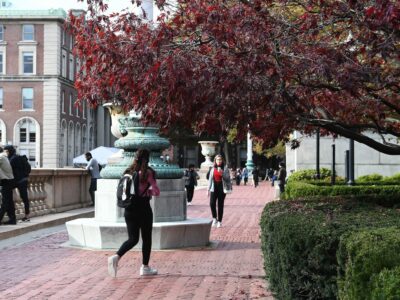
By Elisabeth Gawthrop, Climate and Society ’13
Nicole Davi, a postdoctoral scientist at the International Research Institute for Climate and Society and the Lamont Doherty Earth Observatory, thinks tree rings are an ideal way to motivate students to collect and analyze data as well as to learn about climate change. She and her colleagues are developing curriculum, interactive tools, guides and multimedia that educators may use to engage students in environmental and climate sciences. Check out her AGU e-poster.
The premise of your project is that we’re failing to inspire and teach students about science at an early age. Did you have any specific experiences that prompted you to identify this need?
One conversation that stands out was one with my neighbor’s middle-school daughter a few years back. She is an extremely bright student, but she kept telling me how boring science is! I asked her to show me her science textbook. After looking through it, I had to agree with her that the way the material was presented was, in fact, boring.
Some of the most compelling aspects of science and being a scientist are too often overlooked in the classroom. Students can’t fully grasp science unless, in addition to the lab or exercise they are doing, they also understand the potential importance of what they are doing. They also need to be exposed to the creativity and drive that characterize many scientists. Many of us, especially from IRI and Lamont, work in remote and beautiful parts of the world. These expeditions and stories from the field could be used to appeal to students’ adventurous side and engage them with the research and the science behind the studies.
Why do you think tree-ring science can be a “gateway” science for students?
Many kids can look out the window or be in a park and see trees growing. They generally already have some understanding of how a tree grows. It is easy to help children understand and observe that if, for example, a summer is dry, a tree will grow a smaller annual ring that year or a very wet year would result in a lot of growth and a very wide annual ring.
This is important because scientists can develop long histories of climate from long-lived trees. This concept can be easily reproduced with limited costs in a classroom and can give students an idea about how scientists ask questions, perform experiments, and study climate change. Tree ring studies are also interdisciplinary and a great resource to teach students not only about climate and the earth sciences, but also other topics such as mathematics and biology.
What are the projects already underway that incorporate tree-rings into lesson plans and learning modules?
We have two projects that focus on elementary school children. We are collaboratively developing class lessons that focus on climate change and how scientists study climate, and we developed a field component so that kids could get out in the field and take their own tree ring samples. We also introduced kids to an online climate analysis tool so that they can investigate climate change anywhere on earth. They learned the technology so quickly, faster than teachers actually, and they found some very interesting climate trends!
How did the 5th grade students respond to their trip in the field?
They were amazing! They were very excited to be out in the field and get their hands on increment borers, the main tool we use in the field to take samples from trees. We talked about the ecology of a field site, how a scientist would approach sampling, and what we could learn about climate and ecology from the trees we were seeing.
We also did a tour of the Tree Ring Lab at Lamont. One thing that was very surprising was the kids’ reaction to our sample room where we store hundreds of boxes of cores from all over the world. They spent a lot of time exploring the boxes. They were very excited to find cores from countries where they may have family members. The same thing happened when kids were using the online climate analysis tool – many of them searched countries where they have family.
Translating complex scientific concepts to elementary students can be a challenge. Can you describe the steps you and your collaborators take to ensure that they are usable for teachers and understandable to students?
These projects are driven by teacher and student needs. Teachers have standards they must follow and limited time, and they know best how to teach kids. One of my goals is to communicate to teachers and students what it means to be a scientist, including elements such as idea development, trying to get your ideas funded, the logistics of launching an expedition and carrying out the research, publishing, and interacting with the scientific community. Scientists fail sometimes – things go wrong in the field more often then we would like to admit – but scientists are great at figuring out how to get things to work or taking a new approach. There is a lot of opportunity to make science more human and relatable, which might make it more appealing and accessible to students.



